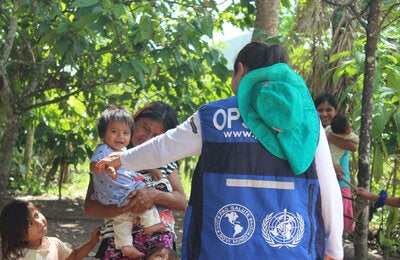
Rabies cases in dogs and humans have declined 95% in the region over the past 35 years. In 2017, just 19 cases were reported in Bolivia, Guatemala, Haiti and the Dominican Republic. The Americas are advancing toward elimination.
Washington, D.C., 21 September 2018 – Only four countries of Latin America and the Caribbean continue to report cases of canine rabies, according to data released by the Pan American Health Organization (PAHO) in advance of World Rabies Day, Sept. 28.
In 2017, fewer than 1,000 dogs contracted rabies, and 19 people died from the disease in the region. Ninety percent of the cases in dogs and 100% of the human cases were reported in Bolivia, Guatemala, Haiti and the Dominican Republic.
“No one should die from a disease that is 100% preventable by a vaccine,” said Ottorino Cosivi, Director of PAHO’s Pan American Foot-and-Mouth Disease Center (Panaftosa) in Brazil. “Eliminating all human deaths from dog-transmitted rabies by 2030 is an achievable goal for our region.”
Rabies cases in dogs and humans have declined 95% in the region since 1983, when PAHO began coordinating regional action to eliminate human rabies in the region. Globally, 59,000 people die every year from the disease, principally in Asia and Africa.

Most countries in the Americas have eliminated the disease. Canine rabies remains endemic only in Bolivia, Guatemala, Haiti and the Dominican Republic, while in Argentina, Brazil, Cuba, Peru and Venezuela report isolated cases that make up 10% of the total.
“As long as there are dogs that have rabies, the risk to humans remains,” said PAHO”s regional advisor on rabies at Panaftosa, Marco Vigilato. “We need to strengthen rabies programs by improving surveillance and vaccination coverage for dogs in high-risk areas.”
In up to 99% of cases, domestic dogs are responsible for transmission of rabies virus to humans, mainly through bites. Children are most vulnerable because they tend to be in closes contact with dogs. In Latin America and the Caribbean, cases are concentrated in the outskirts of large cities and in border areas, where access to vaccination and health services is limited.
The only way to interrupt rabies transmission is by vaccinating at least 80% of the canine population in endemic areas. In the Americas, some 100 million dogs are vaccinated each year. However, coverage in some areas is lower than recommended.
Moreover, to achieve elimination, PAHO recommends ensuring timely access to pre- and post-exposure prophylaxis to 100% of people exposed to the virus, as well as maintaining strong surveillance, raising awareness in the community, controlling the dog population, and taking action to prevent the reintroduction of rabies into countries where it has been controlled.
In 1983, PAHO launched the Program to Eliminate Human Rabies Transmitted by Dogs, which coordinates regional action among a range of partners and created an epidemiological surveillance system for the disease. Countries began carrying out mass dog vaccination campaigns that led to sustained reductions in the number of both human and canine rabies.
links:
— Rabies
— Action plan to eliminate human rabies transmitted by dogs
— Alianza Global para el Control de la Rabia



